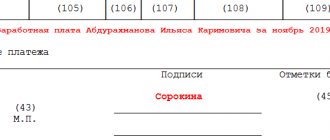All organizations necessarily have to deal with credit institutions. The bank provides services related to finance, and you have to pay for these services. The company incurs fixed costs for banking operations.
What kind of expenses can be considered such expenses? How to correctly reflect them in accounting? How are they treated for tax purposes? What wiring should I use? We explain in detail below, and also consider how specific issues related to the qualification of bank commissions for the most popular services provided to legal entities are correctly resolved.
Question: How is payment for bank services for the monthly transfer of funds from the organization’s current account to the bank accounts of employees when paying wages reflected in the organization’s accounting? In accordance with the collective agreement, wages are transferred to the bank accounts of employees. The cost of the bank's services for transferring funds when paying wages this month, according to the acceptance certificate for services provided, amounted to 7,000 rubles. View answer
What determines financial relations with a bank?
When working with a banking organization, a legal entity enters into a relationship with it with certain obligations of both parties. In order for cooperation to begin, it needs to be documented. These obligations are governed by the agreement signed between the parties:
- to open a bank account (Article 845 of the Civil Code of the Russian Federation);
- for placing a deposit (Article 834 of the Civil Code of the Russian Federation);
- to receive credit funds (Article 819 of the Civil Code of the Russian Federation);
- factoring (financing against the assignment of a claim on funds);
- other financial relationships permitted by the Charter of the credit organization and the legislation of the Russian Federation.
Question: Is it possible for a developer to take into account the costs of bank services for sending an equity participation agreement to Rosreestr under the simplified tax system? View answer
Paid banking services
Banking operations regulated by domestic legislation are listed in Art. 5 of Federal Law No. 395-1 of December 2, 1990 “On Banks and Banking Activities” as amended on July 26, 2021. The most popular and frequently encountered among them are the following:
- opening and maintaining accounts of legal entities;
- cash settlement services (payments, collection, cash issuance, etc.);
- sale of currency (cash and non-cash form);
- issuing loans;
- trust management of funds and/or property;
- rental of safe deposit boxes for storing papers and valuables;
- lessor functions, etc.
All these operations for the bank client are subject to a commission - a fee for the provision of these services under the concluded agreement.
How to take into account bank services when calculating income tax ?
Accounting entries for commercial banking structures
The accounting entries of commercial banking structures are quite diverse. Let's look at the most common of them.
- Debit 20202 “Cash desk of credit organizations” (asset) Credit 40702 “Commercial organizations” (liability) – reflects the transfer of cash to the cash desk of a banking structure for crediting to some current account of a specific client;
- Debit 91207 “Forms” (asset) Credit 99999 “Account for correspondence with active accounts with double entry” (liability) – reflects the transfer of check books and forms to the cash desk of the banking structure;
- Debit 99999 “Account for correspondence with active accounts with double entry” (liability) Debit 91207 “Forms” (asset) – reflects the issuance of check books and forms from the cash desk of the banking structure;
- Debit 40702 “Commercial organizations” (liability) Debit 20202 “Cash desk of credit organizations” (asset) – reflects the write-off of funds from the client’s current account for issuing him cash from the cash desk of a commercial banking structure;
- Debit 20202 “Cash desk of credit institutions” (asset) Credit 20209 “Cash in transit” (asset) – reflects the receipt of cash from the cash settlement center to the cash desk of a commercial banking structure;
- Debit 20209 “Cash in transit” (asset) Credit 30102 “Correspondent accounts of credit institutions” (asset) - reflects the receipt by a commercial banking structure of an extract from the RCC on the withdrawal of cash support from the correspondent account of a financial institution;
- Debit 20209 “Cash in transit” (asset) Credit 20202 “Cash desk of credit organizations” (asset) – reflects the issue of cash from the cash desk of a commercial banking structure for its transfer to the cash settlement center;
- Debit 30102 “Correspondent accounts of credit organizations” (asset) Credit 20209 “Cash in transit” (asset) – reflects the receipt by a commercial banking structure of an extract from the RCC on the crediting of the amount of cash that was collected;
- Debit 20209 “Cash in transit” (asset) Credit 20202 “Cash desk of credit organizations” (asset) - reflects the transfer of cash from the cash desk of a commercial banking structure to bolster the branch cash desk;
- Debit 30302 “Settlements with branches located in the Russian Federation” (asset) Credit 20209 “Cash in transit” (asset) - the write-off of cash from the correspondent sub-account of the branch is reflected; cash was written off in exchange for the cash that was transferred to it;
- Debit 20202 “Cash desk of credit organizations” (asset) Credit 30302 “Settlements with branches located in the Russian Federation” (asset) – reflects the receipt of cash from the cash desk of a commercial banking structure;
- Debit 20208 “Cash in ATMs” (asset) 20202 “Cash desk of credit institutions” (asset) – reflects the issuance of non-greedy funds from the cash desk of a commercial banking structure to the ATMs of a financial institution;
- Debit 409026 “Collected cash proceeds” (liability) 47422 “Liabilities for other operations” (liability) - reflects the receipt of collected cash in the cash desk of the commercial banking structure.
As can be seen from the listed accounting entries, accounts in financial institutions differ from the accounts of commercial organizations: different numbering of business transactions, including the number of characters. Business transactions in banking structures are reflected directly on the same day, which means a complete ban on postings for the previous period.
Do you need to select material for your study work? Ask a question to the teacher and get an answer in 15 minutes! Ask a Question
Features of charging fees for banking services
The amount of the bank commission is established in a contractual form. It cannot be changed by any party - neither the client nor the bank; to do this, you will have to change the existing agreement or accept a new one.
FOR YOUR INFORMATION! Commissions are not paid separately; during the operation, the bank withdraws these funds from the customer’s account and issues a special bank order for them.
Clause 9.3 of Regulation No. 383-P, which was approved by the Bank of Russia on June 19, 2012, specifies two equally legitimate options for withdrawing payment for bank services from the client:
- with preliminary acceptance - that is, before money for services is withdrawn, the client must agree to this;
- without informing the payer - automatically.
How to take into account the costs of banking services ?
The terms for collecting commissions are negotiated individually; this can be either a daily calculation or other selected and agreed upon periods.
Ambiguous issues of accounting and tax accounting of bank commissions
The organization's fixed costs for paying commissions for banking services must be correctly recorded in accounting. This seemingly simple question contains several pitfalls that a competent accountant needs to avoid.
What are these expenses: other or non-operating?
What cost item should be included in the money charged for services by the bank? On the one hand, these are funds directly related to the activities of the organization. But on the other hand, this connection when paying for banking transactions is not always obvious. For example, a company took out a loan and opened an account to support it. Since this account accompanies a targeted loan intended for running a business, we can talk about “other expenses for production and sales” (clause 1 of Article 264 of the Tax Code of the Russian Federation). But the accompanying invoice itself has nothing to do with the main activity of the legal entity, it only accompanies the loan, so the commission for it can be qualified as non-operating expenses (clause 1 of Article 265 of the Tax Code of the Russian Federation).
IMPORTANT! Tax authorities will not consider any of the positions adopted by the organization an error, since neither other nor non-operating expenses affect the income tax base.
Difficulties of lending
Taking out a loan is a popular and widely demanded banking service. Often, the loan agreement includes conditions for the company to make additional payments to the bank. How to correctly account for the commission for these services? The Ministry of Finance responds in two ways:
- if commissions are expressed as a fixed figure, then these expenses can be regarded as other or as non-operating expenses;
- if the commission represents a certain share (percent), the expenses will be treated as “interest on debt obligations” (Article 269 of the Tax Code of the Russian Federation).
NOTE! The commission for a number of other banking services, such as opening a letter of credit, factoring agreement, etc. should also be qualified as a percentage of the debt obligation (letters of the Ministry of Finance of the Russian Federation dated June 18, 2009 No. 03-03-06/1/408 and dated May 13 2009 No. 03-07-11/136).
Making payments for the purchase of assets
The bank can participate in such operations not only by processing payment instruments, but also, for example, by opening a letter of credit. The accountant has a question: are bank commissions included in the initial cost of the asset purchased in this way? After all, it consists of all the costs of acquiring it. Or should we include it among other or non-operating expenses as a fee for a banking service?
The last position is more profitable for the company because:
- the amount is written off from taxable income immediately and not through depreciation;
- contracts for the purchase of an asset and for payment for a banking service are not related to each other.
Salary card service
This is the predominant method of paying labor remuneration today. The bank, of course, charges a commission for crediting money to employees’ card accounts, as well as for the plastic cards themselves. Tax authorities do not recognize the same expenses:
- The fee for processing documents for crediting salary funds is part of the production costs for organizing settlements with personnel. Therefore, it is legitimate to take this money into account as production costs that reduce the organization’s profit (letters from the Ministry of Finance of the Russian Federation dated April 20, 2009 No. 03-03-06/2/88 and dated August 4, 2008 No. 03-04-06-02/88).
- The payment to the bank for issuing, re-issuing and servicing plastic cards is not directly related to the costs of paying salaries, that is, it is not justified from the point of view of the company’s expenses (the costs are borne by the organization, and employees use the cards). In light of the latest clarifications from the Ministry of Finance, these costs are allowed to be included in other expenses, while excluding them from the income of employees, because employees do not choose this particular form of receiving wages, it is prescribed in their employment contracts, which means that the cards are made by the bank specifically for the company, and not for them personally.
Commission for “non-banking” services provided by the bank
One of the important points when reflecting bank commissions as expenses reflected on the taxable base is to determine whether they relate directly to banking services. If the bank charged a commission for a service not included in the list of Federal Law No. 395, for example, provided advice, the company can no longer recognize these funds as other or non-operating expenses and reduce taxable profit. It will be necessary to qualify such payments as costs for consulting and other services or as other costs of production or sales (subparagraphs 15 and 49 of paragraph 1 of Article 264 of the Tax Code of the Russian Federation).
Accounting and postings
Definition 1
Accounting in the banking structure is the process of generating systematized data on all accounting objects in accordance with the requirements established by current regulations, and generating financial statements on their basis.
According to the requirements of current regulations, all banking structures are required to maintain financial records.
The regulation on the chart of accounts for banking structures and the procedure for its use is approved by Bank of Russia Regulation No. 579, while the postings of a banking structure differ significantly from the postings of other organizations and economic entities.
Definition 2
An accounting entry (also called an accounting record) is a record on paper or electronic media of the movement of accounting objects and changes in their status.
Finished works on a similar topic
- Course work: Accounting entries in a commercial bank 430 rub.
- Abstract Accounting entries in a commercial bank 250 rub.
- Test work Accounting entries in a commercial bank 230 rubles.
Receive completed work or specialist advice on your educational project Find out the cost
As a rule, a classic accounting entry includes a description of the debited and credited accounting object, as well as the numerical characteristics of the change, for example, quantity (in kind) and value (monetary expression).
Accounting entry can also be represented as one of the methods of recording business transactions on two different, but at the same time economically closely interconnected accounting accounts, without fail in identical quantities.
Note 1
It is worth noting that accounting entries can only be generated on the basis of primary documentation.
To generate such a posting, it is necessary to implement the following procedures:
- establish the economic content of the accounting object;
- recognize the accounting object;
- in conclusion, technically reflect the accounting object in the debit of one and in the credit of another accounting account.
Today, there are two types of accounting entries:
Need advice from a teacher in this subject area? Ask a question to the teacher and get an answer in 15 minutes! Ask a Question
- simple wiring. Simple transactions are transactions that involve only two accounts;
- complex wiring. Complex transactions are transactions that involve more than two accounting accounts. An example of complex posting is a situation where one account is debited and at the same time several accounts are credited, and the sum of all credited accounts is strictly equal to the amount of the debited account.








